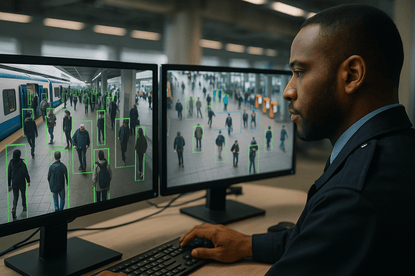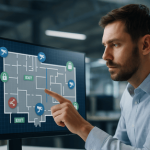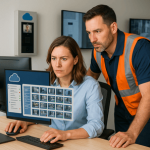
When most people hear “video surveillance,” they think of footage stored for after-the-fact review—or maybe an alert triggered by motion at 2 a.m. But in 2025, modern transit hubs need more than motion detection and old-school CCTV. They need real-time insight, automated awareness, and proactive alerts.
Enter AI-powered surveillance.
At SSP, we’ve seen a major shift in how transit authorities and transportation facility managers are using AI video systems—not just to catch incidents, but to prevent them and even optimize daily operations. In this article, we’ll explore how today’s AI surveillance tools are redefining safety, efficiency, and situational awareness in transportation environments.
k
k
What Is AI Surveillance—And Why Should Transit Operators Care?
AI surveillance systems go far beyond traditional security cameras. Instead of simply recording what happens, they interpret what’s happening in real time using machine learning and computer vision.
This means your system can:
-
Detect specific behaviors (like loitering or tailgating)
-
Recognize vehicles or people of interest
-
Alert operators to anomalies without manual monitoring
-
Filter out irrelevant motion (wind, birds, shadows)
-
Trigger workflows—like locking a door or sending an alert
For transit hubs, public terminals, and multi-use facilities, these capabilities are invaluable.
k
k
Key Use Cases in Transportation Facility Security
Here’s how SSP clients in public transit and logistics are already benefiting from AI-enhanced surveillance:
1. Crowd Monitoring for Safety and Flow Control
Busy terminals can easily become overcrowded—especially during delays, peak hours, or emergencies.
AI video analytics can:
-
Monitor crowd density in real time
-
Trigger alerts when people exceed safe thresholds
-
Help staff direct flow or open additional lanes proactively
-
Identify when platforms or gates are overwhelmed
This improves both public safety and the passenger experience—without requiring additional personnel.
k
k
2. Loitering & Vandalism Detection in Off-Hour Zones
Transit hubs have areas that are active during the day but vulnerable at night—like parking decks, station platforms, or restroom areas.
AI surveillance can:
-
Recognize when someone is lingering too long in a restricted area
-
Differentiate between normal foot traffic and suspicious behavior
-
Send alerts to remote monitoring teams or on-site officers instantly
It’s like having eyes on every corner, without needing a guard at every post.
k
k
3. Slip, Trip, and Fall Detection for Passenger Safety
One of the most overlooked benefits of smart surveillance is accident detection. With AI, cameras can recognize sudden falls or abnormal movement, even in crowded environments.
Why it matters:
-
Faster response to medical emergencies
-
Documentation for incident reports and insurance
-
Identification of high-risk areas for future safety improvements
For transportation facility managers, this helps reduce liability and demonstrates a commitment to public well-being.
k
k
4. Operational Insight: Monitoring Vehicle Dwell Times and Gate Congestion
AI isn’t just for safety—it’s a powerful operational tool too.
In bus depots, railyards, and transit loading zones, AI surveillance can:
-
Track how long vehicles stay at loading bays
-
Identify bottlenecks in traffic or queuing
-
Optimize scheduling based on movement patterns
-
Spot unauthorized parking or blocked access lanes
This transforms cameras from passive recorders into tools that actually improve efficiency.
k
k
Why AI Is a Game-Changer for Public Transit Surveillance
Traditional security systems leave too much up to chance. Either you catch something as it happens—or you’re digging through footage hours later.
With AI surveillance, you’re not just reacting—you’re getting ahead of the problem.
✅ Fewer false alarms
✅ Faster incident response
✅ Better coverage with fewer personnel
✅ Deeper insight into passenger behavior and facility usage
At SSP, we integrate these systems into broader transportation facility security strategies, combining video, access control, and communication tools into one streamlined platform.
k
k
Final Thoughts: Security That Supports Operations
The best security systems don’t just detect threats—they support the mission of your facility. For transit hubs, that means keeping people moving safely, efficiently, and confidently.
With AI-powered surveillance, SSP helps transit authorities and facility managers protect people and improve performance—without adding complexity to your day.
Discover how SSP keeps transportation systems secure and operational.
Contact us today to explore AI video solutions customized for your facility.


